|
Special Features





Image Libraries


|
|
Blog
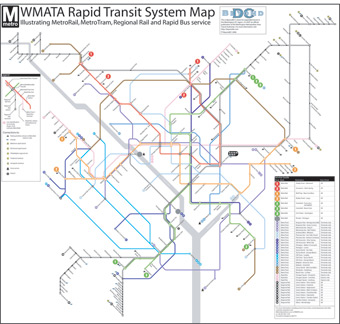
What you see above is not a fantasy. It is an achievable vision of transit expansion in the Washington region. The main assumption is that rather than spending billions on three or four MetroRail extensions, we could achieve far greater coverage and efficiency by recognizing that one size does not fit all, and matching the mode to the corridor. MetroRail, great as it is, is too expensive to build everywhere, and though MetroRail extensions to Woodbridge, Centreville and BWI might be wonderful in those individual corridors, for about the same cumulative cost we could have a far greater affect on regional travel by blanketing arterials inside the Beltway with light rail and upgrading our existing commuter rail infrastructure into true regional interurban lines, with weekend service, hourly trains, etc.
To be sure, we’re proposing a lot of spending here. No doubt to the tune of ten figures. But the costs would be comparable to what Maryland, Virginia and the District are planning to spend on transportation over the next couple of decades anyway. Our plan is merely a reallocation.
For the record, BeyondDC doesn’t mean to suggest that MetroRail isn’t worth the money. Metro’s effect on the Washington region has been nothing short of revolutionary; it has been worth every penny spent, many times over. Furthermore, streetcars alone would be incapable of providing all the rail transit necessary for a city as large and diverse as ours. This vision can only be taken within our regional context of 100 miles of existing MetroRail service. Indeed, where we think MetroRail is the best mode for a new route, such as between the Orange line and Tysons Corner, we’ve included it despite the cost. The point here is that given what we already have, streetcars and interurbans are the best capital investment we can make right now. After these lines are built it may once again make sense to build significantly more MetroRail.
Clicking the map above takes you to our new Transit Vision feature. There you’ll find not only a larger version of the diagram, but also a geographic map (including proposals in Baltimore, Frederick and Annapolis), as well as additional explanation.
A final note before you go: Making such hard decisions as MetroRail versus streetcars is only necessary in the first place because our country’s transportation spending is wildly out of whack. Decades of widenings and new roads have brought our planet to the brink of disaster, ruined our cities, and taken our economy hostage, all with the result that congestion is far worse now than when we started. Like pre-industrial medicine focusing on bloodletting, highway engineering is junk science. The time, lives and money spent on it don’t change the fact that it simply doesn’t work. For all the arguments and numbers BeyondDC is throwing out contending that Metro isn’t the most efficient use of our transportation dollars these days, anything given over to road or parking capacity is severely worse-spent. More MetroRail would be good; it’s just that more streetcars would be better. More roads, in any event, would be utterly counterproductive.
Update: After a discussion at Ryan Avent’s The Bellows, we made some well-needed modifications to the text. Unrelatedly, we also uploaded new, more clear geographic maps. They’re similar to the originals, but we fidged around a bit with line weights to make them more readable. – 3/25/08
Average Rating: 4.7 out of 5 based on 266 user reviews.
March 24th, 2008 | Permalink
Tags: transportation

|

Part of the Kentlands redevelopment plan. Click for pdf. |
Believe it or not, in the 1980s and 90s Gaithersburg was one of the most progressive urban planning cities in the country. Under then mayor Ed Bohrer, Gaithersburg pioneered the idea of improving soulless postwar suburbs through new urbanism and smart growth. The Kentlands neighborhood and the Washingtonian Center were the very first of their kinds in the country, and along with the city’s mixed-use zoning district, have served as models for dozens if not hundreds of copycats. Kentlands is still one of the most compelling and authentic new urbanist developments in America, and without Washingtonian’s example of urban format big boxes (including the first such Target), Columbia Heights would almost certainly not be the District’s new retail mecca.
Bohrer’s 1998 death was a major blow to Gaithersburg. Although some sizable urban projects have been planned, most notably Watkins Mill Town Center and Aventiene, more typically suburban politics have taken hold in the city this decade.
The next decade, however, could be another renaissance. One way or another the Corridor Cities Transitway will redefine transportation in Gaithersburg. Watkins Mill and Aventiene will (hopefully) finally be built, and residents of Kentlands, now more than 20 years old and undergoing its first round of redevelopment, are pushing for better transit access, drastically higher density, and buildings up to 20 stories in Midtown, Kentlands’ mixed-use center (renderings). But for all that, Gaithersburg’s true center has and will remain the edge city district surrounding the intersection of Frederick and Montgomery Village Avenues, near Lakeforest Mall. It’s that part of town that has long been considered hopeless, but it’s that part of town that may soon receive a major boost.
The 62-acre Montgomery County Fairgrounds are smack in the middle of the worst-but-most-important part of Gaithersburg. They are directly between I-270 and the MARC Brunswick line to the west, and Old Town Gaithersburg and Lakeforest Mall to the east. They are, in short, right where downtown Gaithersburg should be, if only it existed. The fair may be cool, but those 62 acres sit virtually empty most of the year, not even useful as parkland. Except during fair season, the grounds are at best used as a huge parking field for the one block of warehouses situated at the far east side of the site. Frankly, the Fairgrounds’ continued existence is an absolute sin for a location as central as it is, especially considering its potential for direct rail access.
Lo and behold, it turns out the cost of maintaining the 60-year-old facility, located where it is when Gaithersburg was still a sleepy railroad town, is getting to be unbearable. The fair, organization leaders believe, might do better elsewhere, with new buildings, more land, and more compatible neighbors. Just where exactly that elsewhere would be is still up in the air, but an idea that would have seemed unthinkable just a few years ago has now officially been floated – to relocate the fair then sell and develop the existing grounds.
If it happens, the city will follow its time-honored charrette process, first popularized in Gaithersburg by Mayor Bohrer, and produce a development plan that could do for Gaithersburg what the Silver line is supposed to do for Tysons Corner – stitch together an incoherent conglomeration of strip malls and fast food shacks, and begin the process of turning it into real, genuine urbanism.
And if *that* happens, Gaithersburg could well start to bear an amazing resemblance to Arlington, with its string-of-pearls urban villages.
Average Rating: 4.7 out of 5 based on 174 user reviews.
March 20th, 2008 | Permalink
Tags: development

The number of major new rail and bus projects on track for federal funding dropped from 48 in 2001 to 17 in 2007, even as transit ridership hit a 50-year high last year and demand for new service is soaring.
And for the record, those numbers are before the FTA went on a project-killing spree early in 2008 that knocked off the Silver line and Miami’s North corridor, among others. It’s all you really need to know about the Bush administration’s transportation ideology, which is ostensibly market-based. If you really want to delve deeper though, check out the rest of today’s Post article on the subject, then compare it with the article about a Transportation Planning Board study detailing a potential future of tolls on existing highways.
The TPB’s vision: Balance transportation by making drivers pay user fees and sinking the toll profits into expanding transit.
Bush’s vision: Reduce highway congestion by selling roads to private businesses who will toll highly enough to discourage use. Toll profits go to private businesses. Users who are discouraged from using the highways… are somebody else’s problem.
Average Rating: 4.5 out of 5 based on 191 user reviews.
March 17th, 2008 | Permalink
Tags: government, transportation

|
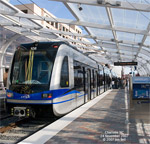
Charlotte’s new light rail. Yes, *that* Charlotte. |
A couple of days ago BeyondDC wrote that behavioral changes, not techie doodads, are the answer to our environmental woes. Lest readers be tempted to think behavioral change among the American public is an impossible dream, we’ll make special note of a Reuters article reporting that American transit ridership hit a 50-year high in 2007. Reads the article:
Mass transit use increased by more than 2 percent in 2007 to the highest level in 50 years, with Americans taking more than 10 billion trips on public transport while the number of vehicle miles traveled was flat in the first 10 months of the year…
The largest area of mass transit growth was in light rail use, which includes street cars and trolleys, with a 6 percent increase during 2007. Commuter rails were second with an increase of 5.5 percent in ridership and subway ridership had an increase of 3.1 percent.
Cities with less than 100, 000 people also saw a large increase — 6.4 percent — in public transportation use.
Turns out Americans are not in fact intrinsically tied to their cars. Americans, like people all over the world, follow the path of least resistance. For the past 60 or so years a heap of financial and legal subsidies at every level of government has resulted in a system in which driving is the path of least resistance. But as gas prices rise and transit expands, maintaining those outdated suburban behaviors gets harder and harder, while change becomes ever easier. The more things change, the more things *will* change.
With apologies to Barack Obama – yes, we can.
Update: More on this in a discussion at Ryan Avent’s The Bellows.
Average Rating: 4.8 out of 5 based on 282 user reviews.
March 11th, 2008 | Permalink
Tags: transportation

BeyondDC administers DCurblogs, a directory of websites about urbanity in the DC region. We recently reshuffled the list of sites to break those with a specific local focus down by jurisdiction – DC, Maryland or Virginia. We were surprised to notice that the District has ten sites, Maryland has seven, and Virginia has… a big fat goose egg.
There have got to be blogs out there about Arlington, Reston and Alexandria. Surely somebody out there has something to say about Tysons Corner’s potential transformation from edge city to downtown. Where are they?
Update: Thanks to comments and emails, Virginia is now well-represented. – 3/31/08
Average Rating: 4.7 out of 5 based on 190 user reviews.
March 8th, 2008 | Permalink
Tags: site

|
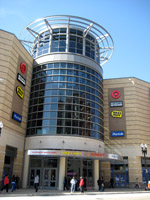
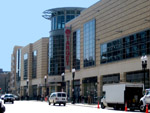
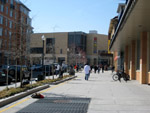
The new Target. Images courtesy Liz Fremer. Click to enlarge. |
Garfinckel’s closed its doors in 1990. Woodies went down in 1995. Although departments stores line the streets of Friendship Heights, for more than a decade the only sizable one in what can reasonably be called the central city has been Hecht’s Metro Center location, built in 1985 and recently converted to a Macy’s. And no offense to Macy’s, but at $27 each it’s a less than ideal place to purchase undershirts.
As of this week, the center city department store slump is officially over, and urbanites finally have a convenient, affordable, Metro-accessible spot to buy socks, trash cans, and toasters. The Columbia Heights Target is finally open for business.
In case anyone wonders how BeyondDC can attack consumerism one day and revel in the opening of a new shopping destination the next, it all comes down to urban form. The new Target and its associated retail pavilion is smack in the center of DC’s most statistically dense neighborhood. It greets the street with storefronts right on the sidewalk. It’s practically on top of a Metro station. Its multi-floor layout uses land efficiently, though it would have been better with apartments on top. OK, there’s a parking garage, but it’s a far cry from the 20 acre ocean of asphalt that’s the average in front of every suburban WalMart. True, the building could have used more architectural variety at the street level, but that’s a relatively minor complaint compared to the use itself. The fact is, the Columbia Heights Target makes urban living easier without causing significant harm to the fabric of the city, and in that sense it is worth its weight in environmentally friendly gold.
Average Rating: 5 out of 5 based on 200 user reviews.
March 7th, 2008 | Permalink
Tags: development, environment, urbandesign

|

NOT green. |
To Worshipers of Consumption: Spending Won’t Save the Earth.
That’s the message from a Post article yesterday titled Greed In the Name Of Green, in which author Monica Hesse takes consumer culture to task for destructive behavior in the name of ecological friendliness. Throwing away your old sheets and replacing them with $570 special “green” sheets from Switzerland is not, Hesse argues, healthy for the planet. She satirically tells us let us never consider the other organic option – not buying – because the new green consumer wants to consume.
It all reminds BeyondDC of an observation our real-life alter ego once made in regard to a so-called “green” WalMart proposed in Colorado: LEED architecture without good urban design is like cutting down the rainforest using hybrid-powered bulldozers. A sprawly WalMart with 20 acres of parking, to which customers drive from miles around, is intrinsically harmful to the environment. It doesn’t matter what kind of bulbs they use to light the store, the effect is B-A-D.
Wanna make a difference, America? Change your behavior. Techno wizardry and organic products are fine, but they make a marginal difference to root behaviors that are inherently anti-green. Instead, try living somewhere walkable. Give up the McMansion for a bungalow or rowhouse. Don’t be a NIMBY. Fight for, not against urban densities and transit. Instead of driving a hybrid, drive less.
In any event, it’s time to give up the pretension that we’re saving the environment by slapping “green” labels on our favorite products, but otherwise enthusiastically continuing the harmful behaviors of the last century.
Thanks to Melissa Esposito of CommuterPageBlog for the head’s up.
Average Rating: 4.7 out of 5 based on 285 user reviews.
March 6th, 2008 | Permalink
Tags: environment

|
Media





Site
About BeyondDC
Archive 2003-06
Contact
Category Tags:
Partners
|




















